Often associated with the Average Directional Index are two colored lines. Often in the hue red and green, these are called the plus (+) and minus (–) Directional Movement Index lines. Actually, the ADX is a derivative of the +/- DI’s.

As we learned in a previous lesson, we trade the trend when the ADX (black) line stays below the 20 for at least one month, and then rises above it. When the ADX line turns downward, the trend is weakening.
Interpreting the +/- Directional Movement Indexes
The + DI is represented in this indicator box by a green line. The – DI is depicted by a red line. The default setting we will use is 14 periods. On our daily charts this means the previous 14 days are used as a data source.
As the stock rises, the +DI (green line) goes up. If the stock falls, the –DI (red line) goes up. The DI line that is on top is referred to as the dominant DI.
- If the red is on top, you can assume a downtrend.
- If the green is on top, you can assume an uptrend.
Creating Entry Signals with the Directional Movement Index
Perhaps the most common way to trade the DMI, is to enter a trade at the crossover point. When the red crosses above the green, go short. If the green crosses above the red, go long.
The following diagram uses blue and red for the + and – DI’s.
WPL with DMI Indicator Box
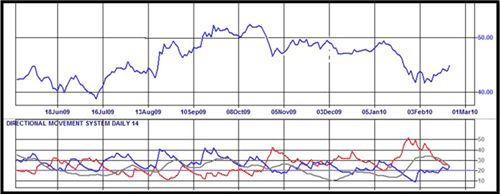
Notice the amount of times the + and the – cross above each other. If a trader were to buy long and sell short each time the DI’s crossed over each other, there would be a severe whipsaw effect. A whipsaw is where a signal is generated and shortly thereafter reversed causing the analyst to overtrade and lose.
How can we create better entry signals with the ADX and the DMI?
Confirming the Signals with the ADX
A couple of methods exist that can be used to increase the reliability of the DMI. The first is simple: use it in conjunction with the ADX. Recall that we only want to buy at the beginning of a trend when the darker colored ADX rises above the 20. This can be further modified by saying as long as the +/- DI’s crossover above the ADX, it is valid. If the crossover occurs below the ADX, the trend is already too far along to trade with confidence.
By analyzing Cougar Metals (CGM) we can see the two types of entry signals, one valid and the other not.
CGM with ADX and DMI indicators
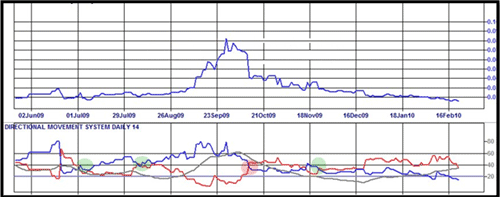
The green circles show where a +/- DI crossover occurs above the ADX line. This can be considered a valid signal. Even better is when the crossover occurs when the ADX is rising above the 20 reference line.
The red circle shows where a sell short signal is generated when the negative DI crosses above the positive. Because the ADX line is above the crossover, the trend is already strongly in play. Jumping aboard this trend would be too risky for the potential gain.
Confirming the Signals with Candlesticks
There is another method to confirm the validity of the signals with the +/- DI’s. To see how this works, we will need to use candlestick and a much more detailed chart. The chart we will look at is ASX Limited. The green box highlights the trading window and bullish indicator we will consider.
ASX Limited with ADX and DMI indicators
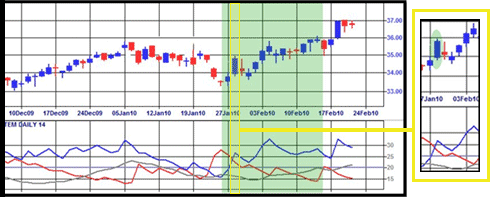
We will zoom in further yet again (in yellow box).
The exact day of the bullish crossover is analyzed. This day of price action is colored green. The first thing we do when a crossover occurs is to take note of the daily extremes.
If it is a bullish crossover, we record the daily high. To enter the trade, the following days prices must be higher than the daily high we recorded on crossover day.
In this example, the price went as high as 35 dollars on crossover day. The next day the prices fell so we do not buy. We wait until the prices do break above our 35 dollar trading confirmation. Or we have the option of backing out of this trade if we feel it failed.
Four days later the price did rise above the daily highs of the crossover day. That would be our first valid entry point.
We will now consider candlestick confirmation when the - DI crosses above the +DI, or we are assuming a new downtrend. The stock is CSL.AX. The green circle shows the DI crossover as well as the candlestick we are about to analyze.
CSL with ADX and DMI
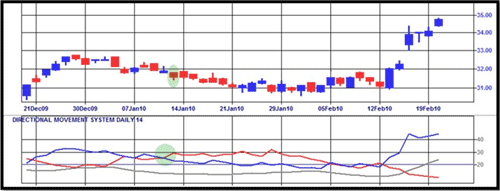
To make this process easier, we merely extend a horizontal line from the lowest point on the crossover day. The price must go lower than this price for our potential downtrend to be valid. If you look carefully at the chart below you can see a thin green horizontal line protruding from the bottom of the candlestick.
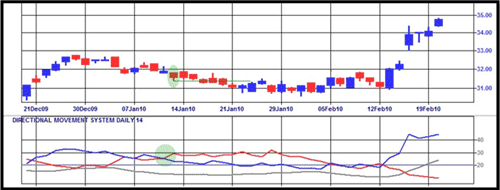
When the prices fall below this point our downtrend is considered valid. But as we look at this chart, the downtrend proves to be quite weak. Even with good technical analysis we still need to be careful and have a razor sharp exit strategy in case of a failed trade.
Looking a little further down the chart around February 13th 2010, we see where the bullish crossover signal that is both above the ADX line and has candlestick confirmation becomes quite profitable.
Trend Trading Rules with +/- DI
- Trade crossovers
- Make sure crossover occurs above ADX line
- Confirm with candlesticks by noting daily price extremes on crossover day
- If bullish crossover, succeeding days must go above the crossover daily high for a valid entry signal
- If a bearish crossover, succeeding days must go below the crossover daily low for a valid entry signal